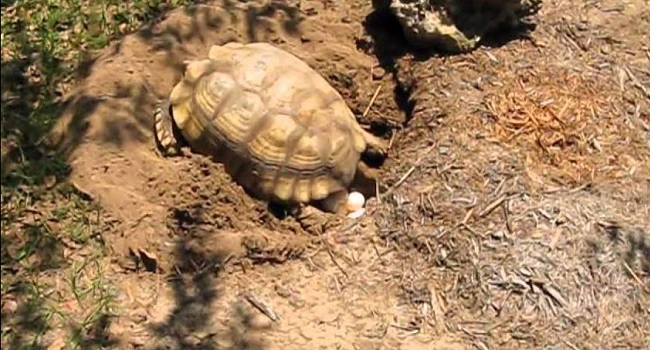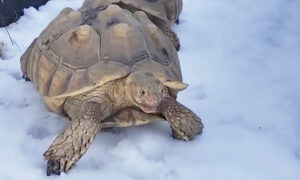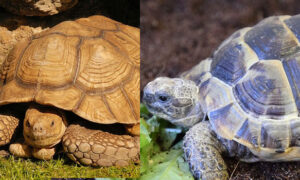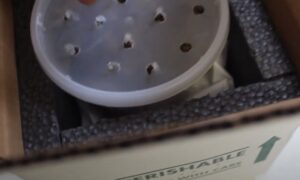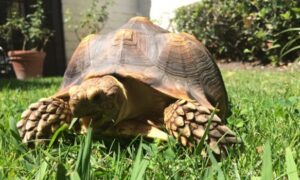In the wild, Sulcata tortoises dig deep burrows that maintain humidity and temperature to ensure a high hatch-rate. When breeding Sulcata tortoises in captivity, it can be harder to maintain a similar natural incubation, which is why most breeders tend to incubate sulcata eggs in an incubator.
It is not impossible for sulcata tortoise eggs to hatch in the nest the female tortoise has built, but for best results at maintaining temperature and humidity during the egg development, an incubator is the best change of a high hatch-rate for sulcata eggs.
Setting Up an Incubator for Sulcata Tortoise Eggs
Maintain Incubation Temperature
The most important factor in incubating sulcata tortoise eggs is being able to maintain the temperature. Too much variation can cause development problems with embryo tortoise babies. It’s important to maintain the incubator between 86-88 degrees Fahrenheit.
Maintain Incubation Humidity
Along with temperature, it’s important to maintain high humidity within the incubator. In order to prevent the sulcata tortoise eggs from drying out, the humidity should be at least 80%, upwards to 90%. The high humidity is necessary to not only prevent the eggs from drying out but also ensure that the embryo receives ample moisture for proper growth and nourishment within the egg.
Choose Incubation Substrate
The tortoise eggs will need to be placed in a incubation substrate that will aid humidity and moisture. There are many options to choose from. Common choices of incubation substrate vermiculite, perlite, Hatch-Rite or Pangea Hatch Medium. These substrates will hold moisture without creating a soggy environment. You’ll want to adjust the amount of water to achieve a damp but not swampy environment.
Select a Secure Incubator Container
The tortoise eggs should be placed in a shallow container with a lid within the incubator. The lid will help maintain consistent humidity levels. Ensure the container is large enough to accommodate the eggs without overcrowding them. Many breeders will place ventilation holes in the container for some airflow. Without a little airflow, you risk mold growth.
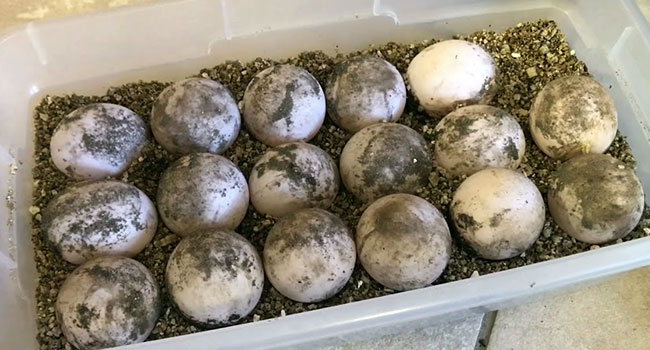
Set up the Tortoise Eggs in the Incubator
When placing the sulcata eggs in the incubator, you want to avoid moving them excessively. Try not to shake them or jostle them too much. Carefully pull the eggs out of the nest and without turning the eggs, place them directly in the incubator container that you’ll use in the incubator. Often times, the eggs are tilted with the pointier side downward. This minimizes risks to the embryo and aids in development within the egg.
How Long will Sulcata Eggs Incubate
Sulcata tortoise eggs will incubate for about 90 to 120 days. Monitor the eggs regularly to ensure humidity and temperature remains consistent. Use a thermometer and a hygrometer to track the temperature and humidity.
Should I Candle the Tortoise Eggs
Candling helps monitor the eggs for development. In most cases, the egg will mold if the embryo doesn’t develop properly and dies within the egg. You use a pen-style flashlight to shine within the egg. You’ll see the veins and growth of the embryo. Again, be very careful not to jostle the egg too much.
Common Problems Incubating Sulcata Eggs
Incubating sulcata eggs isn’t always the smoothest process.
- Mold Growth: Excessive moisture or poor airflow can cause mold growth within the incubation container. You will need to remove the mold and any affected eggs so the mold doesn’t spread to healthy eggs.
- Temperature Fluctuations: If the temperature fluctuates too much, the eggs will not be able to develop properly. Some variation is normal, but excessive changes to the incubator temperature can be detrimental to the tortoise eggs.
- Low Humidity: If the humidity level within the incubator and the containers are not maintained and kept consistent, the eggs will dry out. Dehydrated tortoise eggs will start to dent.
- Egg Abnormalities: During candling, breeders can identify abnormalities such as underdeveloped embryos. Removing these eggs into their own container can prevent issues from affecting other healthy eggs.

